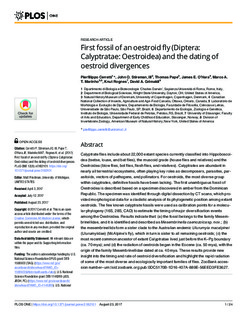| dc.contributor.author | Cerretti, Pierfilippo | |
| dc.contributor.author | Stireman III, John O | |
| dc.contributor.author | Pape, Thomas | |
| dc.contributor.author | O'Hara, James E. | |
| dc.contributor.author | Marinho, Marco A. T. | |
| dc.contributor.author | Rognes, Knut | |
| dc.contributor.author | Grimaldi, David A. | |
| dc.date.accessioned | 2018-04-12T11:34:21Z | |
| dc.date.available | 2018-04-12T11:34:21Z | |
| dc.date.created | 2017-10-31T09:42:05Z | |
| dc.date.issued | 2017-08 | |
| dc.identifier.citation | Cerretti, P. et al. (2017) First fossil of an oestroid fly (Diptera: Calyptratae: Oestroidea) and the dating of oestroid divergences. PLoS One, 12(8): e0182101 | nb_NO |
| dc.identifier.issn | 1932-6203 | |
| dc.identifier.uri | http://hdl.handle.net/11250/2493878 | |
| dc.description.abstract | Calyptrate flies include about 22,000 extant species currently classified into Hippoboscoidea (tsetse, louse, and bat flies), the muscoid grade (house flies and relatives) and the Oestroidea (blow flies, bot flies, flesh flies, and relatives). Calyptrates are abundant in nearly all terrestrial ecosystems, often playing key roles as decomposers, parasites, parasitoids, vectors of pathogens, and pollinators. For oestroids, the most diverse group within calyptrates, definitive fossils have been lacking. The first unambiguous fossil of Oestroidea is described based on a specimen discovered in amber from the Dominican Republic. The specimen was identified through digital dissection by CT scans, which provided morphological data for a cladistic analysis of its phylogenetic position among extant oestroids. The few known calyptrate fossils were used as calibration points for a molecular phylogeny (16S, 28S, CAD) to estimate the timing of major diversification events among the Oestroidea. Results indicate that: (a) the fossil belongs to the family Mesembrinellidae, and it is identified and described as Mesembrinella caenozoica sp. nov.; (b) the mesembrinellids form a sister clade to the Australian endemic Ulurumyia macalpinei (Ulurumyiidae) (McAlpine’s fly), which in turn is sister to all remaining oestroids; (c) the most recent common ancestor of extant Calyptratae lived just before the K–Pg boundary (ca. 70 mya); and (d) the radiation of oestroids began in the Eocene (ca. 50 mya), with the origin of the family Mesembrinellidae dated at ca. 40 mya. These results provide new insight into the timing and rate of oestroid diversification and highlight the rapid radiation of some of the most diverse and ecologically important families of flies. ZooBank accession number–urn:lsid:zoobank.org:pub:0DC5170B-1D16-407A-889E-56EED3FE3627. | nb_NO |
| dc.language.iso | eng | nb_NO |
| dc.publisher | Public Library of Science | nb_NO |
| dc.rights | Navngivelse 4.0 Internasjonal | * |
| dc.rights.uri | http://creativecommons.org/licenses/by/4.0/deed.no | * |
| dc.subject | zoologi | nb_NO |
| dc.subject | fluer | nb_NO |
| dc.subject | fossiler | nb_NO |
| dc.title | First fossil of an oestroid fly (Diptera: Calyptratae: Oestroidea) and the dating of oestroid divergences | nb_NO |
| dc.type | Journal article | nb_NO |
| dc.type | Peer reviewed | nb_NO |
| dc.description.version | publishedVersion | nb_NO |
| dc.rights.holder | © 2017 Cerretti et al. | nb_NO |
| dc.subject.nsi | VDP::Matematikk og Naturvitenskap: 400::Zoologiske og botaniske fag: 480 | nb_NO |
| dc.source.volume | 12 | nb_NO |
| dc.source.journal | PLoS ONE | nb_NO |
| dc.source.issue | 8 | nb_NO |
| dc.identifier.doi | 10.1371/journal.pone.0182101 | |
| dc.identifier.cristin | 1509155 | |
| cristin.unitcode | 217,6,4,0 | |
| cristin.unitname | Institutt for barnehagelærerutdanning | |
| cristin.ispublished | true | |
| cristin.fulltext | original | |
| cristin.qualitycode | 1 | |

